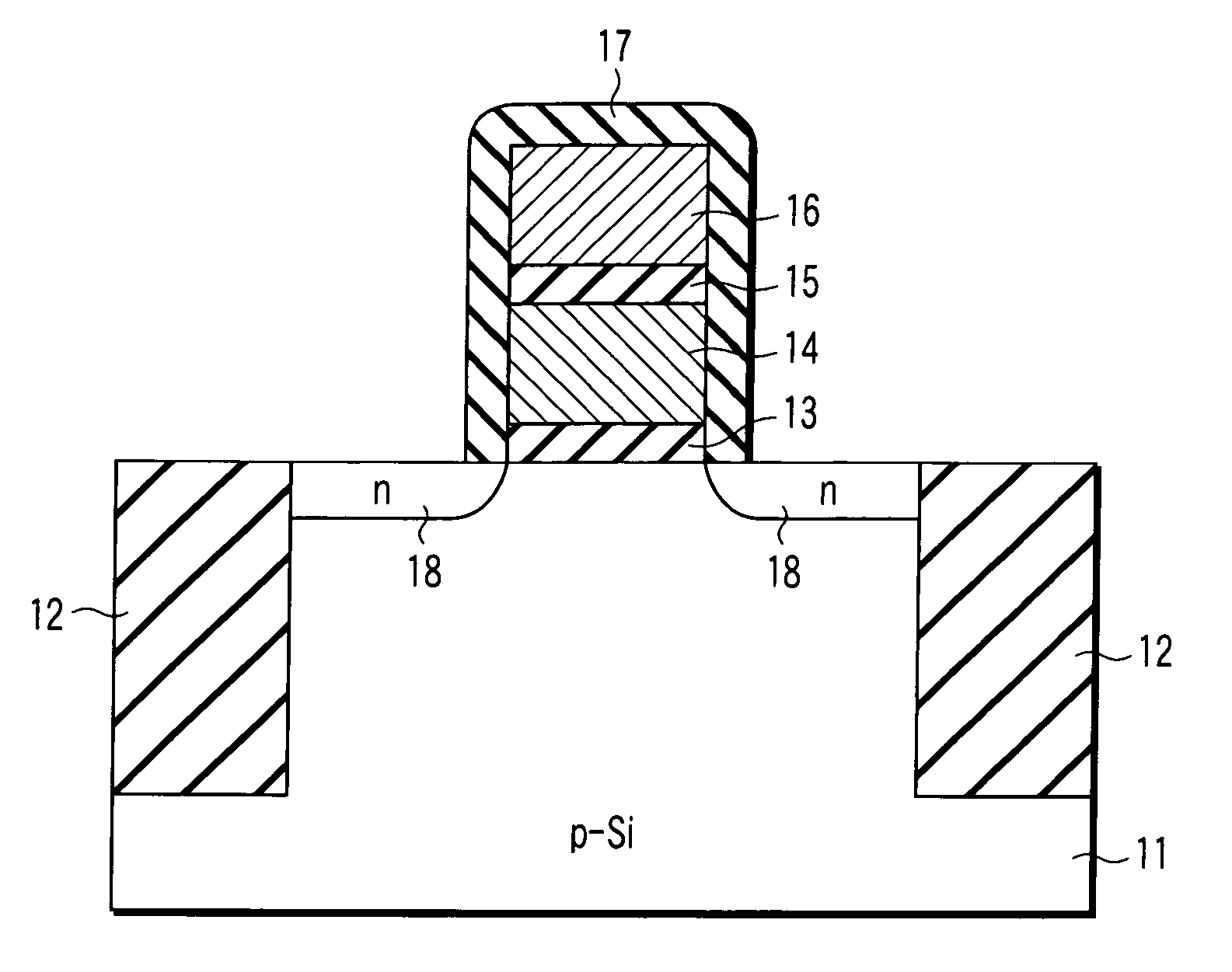Nonvolatile semiconductor memory device, semiconductor device and manufacturing method of nonvolatile semiconductor memory device
- Summary
- Abstract
- Description
- Claims
- Application Information
AI Technical Summary
Benefits of technology
Problems solved by technology
Method used
Image
Examples
first embodiment
[0054] (First Embodiment)
[0055]FIG. 1 is a cross sectional view showing the schematic structure of a nonvolatile semiconductor memory device according to a first embodiment of this invention.
[0056] A silicon thermal oxide film (element isolation insulating film) 12 for element isolation is embedded in and formed on a p-type (first conductivity type) silicon substrate (semiconductor substrate) 11 to surround the element forming area of the main surface of the substrate 11. On the main surface of the silicon substrate 11, a floating gate electrode 14 is formed with a tunnel insulating film (first gate insulating film) 13 disposed therebetween. On the floating gate electrode 14, a control gate electrode 16 is formed with an inter-poly insulating film (second gate insulating film) 15 disposed therebetween.
[0057] The inter-poly insulating film 15 is an ONO film with a thickness of 7 nm formed of a silicon oxide film, CVD silicon nitride film and CVD silicon oxide film, for example. The...
second embodiment
[0078] (Second Embodiment)
[0079]FIGS. 12A to 12E are cross sectional views showing a manufacturing process of a nonvolatile semiconductor memory device according to a second embodiment of this invention, and particularly, a manufacturing process of a tunnel insulating film. Portions which are the same as those of FIG. 1 are denoted by the same reference symbols and the detail explanation thereof is omitted.
[0080] First, as shown in FIG. 12A, the surface of a silicon substrate 11 is oxidized by use of oxygen gas, for example, to form a silicon oxide film 13b with a thickness of approximately 2 nm. Then, as shown in FIG. 12B, for example, a flat amorphous silicon film 13d with a thickness of approximately 1 nm is formed on the silicon oxide film 13b by use of disilane gas.
[0081] Next, as shown in FIG. 12C, the amorphous silicon film 13d is directly nitrided at a temperature of 700° C. under a pressure of 50 Torr (6650 Pa) by using a plasma nitriding method, for example. Thus, a sili...
third embodiment
[0094] (Third Embodiment)
[0095]FIGS. 16A to 16I are cross sectional views showing the manufacturing process of a nonvolatile semiconductor memory device according to a third embodiment of this invention. Portions which are the same as those of FIG. 1 are denoted by the same reference symbols and the detail explanation thereof is omitted.
[0096] First, as shown in FIG. 16A, for example, a p-type (first conductivity type) silicon substrate 11 having plane orientation (100) and resistivity 10 to 20 Ωcm is prepared and a groove is formed in the surface of the silicon substrate 11. An element isolation insulating film 12 with a thickness of approximately 0.6 μm is formed by burying a CVD oxide film in the groove. Then, an oxidizing process is performed at 950° C. by use of oxygen gas to form a silicon oxide film 13b with a thickness of approximately 2 nm on the surface of the silicon substrate 11. Next, for example, an amorphous silicon film 13d of approximately 1.5 nm is deposited at 40...
PUM
 Login to View More
Login to View More Abstract
Description
Claims
Application Information
 Login to View More
Login to View More - R&D
- Intellectual Property
- Life Sciences
- Materials
- Tech Scout
- Unparalleled Data Quality
- Higher Quality Content
- 60% Fewer Hallucinations
Browse by: Latest US Patents, China's latest patents, Technical Efficacy Thesaurus, Application Domain, Technology Topic, Popular Technical Reports.
© 2025 PatSnap. All rights reserved.Legal|Privacy policy|Modern Slavery Act Transparency Statement|Sitemap|About US| Contact US: help@patsnap.com



